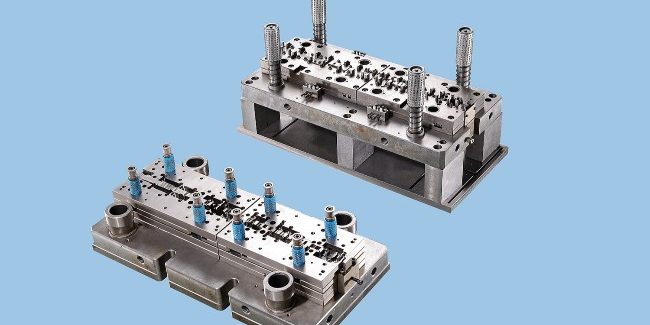There are many reasons affecting the deformation and cracking of metal stamping die, mainly related to the original structure, the chemical composition of steel, the structural shape and section size of parts, heat treatment process and other factors. Cracking is often preventable, but heat treatment deformation is always unavoidable.
In practice, the difference of section size, the structural shape of the stamping die parts, the different rate of heating and cooling in the process of heat treatment (heating – insulation – cooling), under the comprehensive action of thermal stress, organizational stress and phase change volume, cause the volume expansion or contraction of the parts, so that the size and shape deviation, deformation, and even cause cracking.

- Preparation for heat treatment.For the stamping die forgings of eutectoid steel, normalizing treatment should be carried out first, and then spheroidizing annealing should be carried out, in order to eliminate the mesh secondary cementation in the forgings, refine the grain, eliminate the internal stress, and prepare the organization for the subsequent (or final) heat treatment. Low temperature tempering (stabilization treatment) should be carried out before quenching of stamping die parts. For some concave dies with complex shapes and high precision requirements, tempering treatment should be carried out first before finishing after rough machining, so as to reduce quenching deformation, avoid cracking tendency as far as possible, and prepare the organization for the final heat treatment.
- Optimize quenching and tempering process
- Control of temper treatment.After the mold parts are removed from the coolant, they should not stay in the air for a long time, and should be promptly put into the tempering furnace for tempering treatment. When tempering, low temperature tempering brittleness and high temperature tempering brittleness should be avoided. For some precision requirements of die parts, after quenching using multiple tempering treatment, in order to eliminate the internal stress, reduce deformation, avoid cracking tendency.
- Protection of quenched parts.Quenching and tempering are important links that affect the deformation or cracking of die parts during heat treatment. For important quenching die parts (such as punch, concave die) prone to deformation or cracking parts, should take effective protective measures, strive to make the shape of the parts and section symmetry, internal stress balance. Common protection methods are as follows: a. Bale method; b. filling method; c. Clogging method.
- Determination of heating temperature.Quenching heating temperature is too high, making austenite grain coarse, and will cause oxidation, decarburization phenomenon, parts deformation and cracking tendency to increase. In the specified heating temperature range, low quenching heating temperature will cause the parts of the inner hole shrinkage, aperture size becomes smaller. Therefore, the upper limit of heating temperature specification should be selected; For alloy steel, the heating temperature is too high, it will cause the expansion of the inner hole, the aperture size becomes larger, so the lower limit of heating temperature should be selected as appropriate.
- Improvement of heating method.For some small stamping die or long and thin cylindrical parts (such as small punch), can preheat to 520–580℃, and then put into the medium temperature salt bath furnace heating to quenching temperature, than direct use of electric furnace or reflection furnace heating quenching parts deformation significantly reduced, and can control the cracking tendency. Especially for high alloy steel die parts, the correct heating method is: preheat first (temperature is 530–560℃), and then rise to quenching temperature. In the heating process, the high temperature period should be shortened as far as possible to reduce the quenching deformation and avoid the production of small cracks.
- Choice of coolant.For alloy steel, the best way to reduce the quenching deformation is to use potassium nitrate and sodium nitrite hot bath isothermal quenching or fractional quenching, this method is especially suitable for dealing with the complex shape, size requirements of accurate stamping die. Some porous die parts (such as porous die), isothermal quenching time should not be too long, otherwise it will cause the aperture or hole distance to become large. If the cooling shrinkage in oil and the cooling expansion in nitrate are used, the rational application of dual-medium quenching can reduce the deformation of parts.
- Quenching treatment before wire cutting.For some stamping die parts of linear cutting processing, graded quenching and multiple tempering (or high temperature tempering) heat treatment process should be used before linear cutting processing, in order to improve the hardenability of parts, and make its internal stress distribution tends to be uniform, and in a small state of internal stress. The smaller the internal stress, the smaller the tendency of deformation and cracking after wire cutting.
- Optimization of cooling mode.When the parts are taken out of the heating furnace and put into the coolant, they should be placed in the air before proper pre-cooling, and then put into the coolant quenching, which is one of the effective ways to reduce the quenching deformation of parts and prevent the cracking tendency of parts. After the mold parts are put into the coolant, they should be properly rotated, and the rotation direction should be changed, which is conducive to the parts to maintain a uniform cooling rate, and can significantly reduce the deformation and prevent cracking tendency






